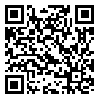BibTeX | RIS | EndNote | Medlars | ProCite | Reference Manager | RefWorks
Send citation to:
URL: http://rehabilitationj.uswr.ac.ir/article-1-222-en.html
Objective: The respiration role is not limited to vital function but it also important in speech process. The present research is aimed to measure different parameters of speech breathing values in patients suffering Mustard Gas injuries versus normal individual.
Materials & Methods: Research was applied as case-control, cross – sectional and analytical method. The sampling pattern was convenience. Among patients, 19 were selected within injured patients from Baghiatallah hospital and 20 from those of normal individuals from welfare and rehabilitation sciences university stuffs. Normal people were matched based on their age, gender and other criterias within 30-50 years of age. ST1 Dysphonia manufactured by G.M. Instruments Ltd.) was used to measure parameters of speech breathing, that include “Vital capacity”, “Phonation time”,” Phonation volume”,” Mean flow rate”,” Total expired volume”. And also,” Vocal velocity index” and “Phonation Quotient” were calculated. The independent T-test was used for data analysis.
by G.M. Instruments Ltd.) was used to measure parameters of speech breathing, that include “Vital capacity”, “Phonation time”,” Phonation volume”,” Mean flow rate”,” Total expired volume”. And also,” Vocal velocity index” and “Phonation Quotient” were calculated. The independent T-test was used for data analysis.
Results: Research findings shown statistically significant difference between two groups in Vital capacity (P<0/001), Phonation time (P<0/001), Phonation volume (P<0/001), Vocal velocity index (P=0/004), Total expired volume (P<0/001) and Phonation Quotient (P=0/046), but there was no significant difference in Mean flow rate between case and control group (P=0/615).
Conclusion: present research has indicated, chemical war substance, not only has rendering effects upon vital respiration, but also has alternate patient’s speech breathing capabilities greatly. Such finding can be measured and evaluated the disturbed phonatory criteria in such patients and be a valued guide for speech & language phatologists, during treating such patients.
Received: 3/11/2008 | Accepted: 12/10/2015 | Published: 12/10/2015
| Rights and permissions | |
 |
This work is licensed under a Creative Commons Attribution-NonCommercial 4.0 International License. |





